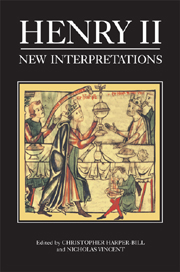Book contents
- Frontmatter
- Contents
- List of Illustrations
- Editor's Preface
- List of Abbreviations
- Introduction: Henry II and the Historians
- The Accession of Henry II
- Henry II and Louis VII
- Doing Homage to the King of France
- Henry, Duke of the Normans (1149/50–1189)
- Henry II and England's Insular Neighbours
- Henry II, the English Church and the Papacy, 1154–76
- On the Instruction of a Prince: The Upbringing of Henry, the Young King
- Henry II and the Creation of the English Common Law
- Finance and the Economy in the Reign of Henry II
- Henry II and the English Coinage
- The Court of Henry II
- Literary Culture at the Court of Henry II
- Henry II and Arthurian Legend
- Index
Henry II and the Creation of the English Common Law
Published online by Cambridge University Press: 12 September 2012
- Frontmatter
- Contents
- List of Illustrations
- Editor's Preface
- List of Abbreviations
- Introduction: Henry II and the Historians
- The Accession of Henry II
- Henry II and Louis VII
- Doing Homage to the King of France
- Henry, Duke of the Normans (1149/50–1189)
- Henry II and England's Insular Neighbours
- Henry II, the English Church and the Papacy, 1154–76
- On the Instruction of a Prince: The Upbringing of Henry, the Young King
- Henry II and the Creation of the English Common Law
- Finance and the Economy in the Reign of Henry II
- Henry II and the English Coinage
- The Court of Henry II
- Literary Culture at the Court of Henry II
- Henry II and Arthurian Legend
- Index
Summary
The reign of Henry II has long been regarded, and rightly, as a period of major importance in the history of English law. For most legal historians it is the period when it first becomes possible to recognise the existence of an English ‘Common Law’: both a set of national legal institutions bringing law and justice to the whole of England, and a body of legal rules applicable over the whole or almost the whole of England. The clearest overall view of this newly emergent English ‘Common Law’ is to be found in the pages of the legal treatise known as Glanvill, which was completed, though not necessarily all written, in the final years of Henry's reign, between 1187 and 1189. Within a few years of the death of Henry II we get the first direct evidence for the operation of the new Common Law in the earliest surviving plea-roll records of the king's courts, the first of which dates from 1194. Our picture of the process by which that Common Law began to emerge is much less clear, since it depends on scattered and fragmentary evidence that is difficult to interpret. It is with that process of emergence that this paper will be mainly concerned.
Let me start, however, by reviewing both what had been achieved and what had not been achieved by the end of Henry II's reign. This is not meant to sound teleological, as though there was some grand plan gradually being put into effect by the king and his advisers.
- Type
- Chapter
- Information
- Henry IINew Interpretations, pp. 215 - 241Publisher: Boydell & BrewerPrint publication year: 2007



